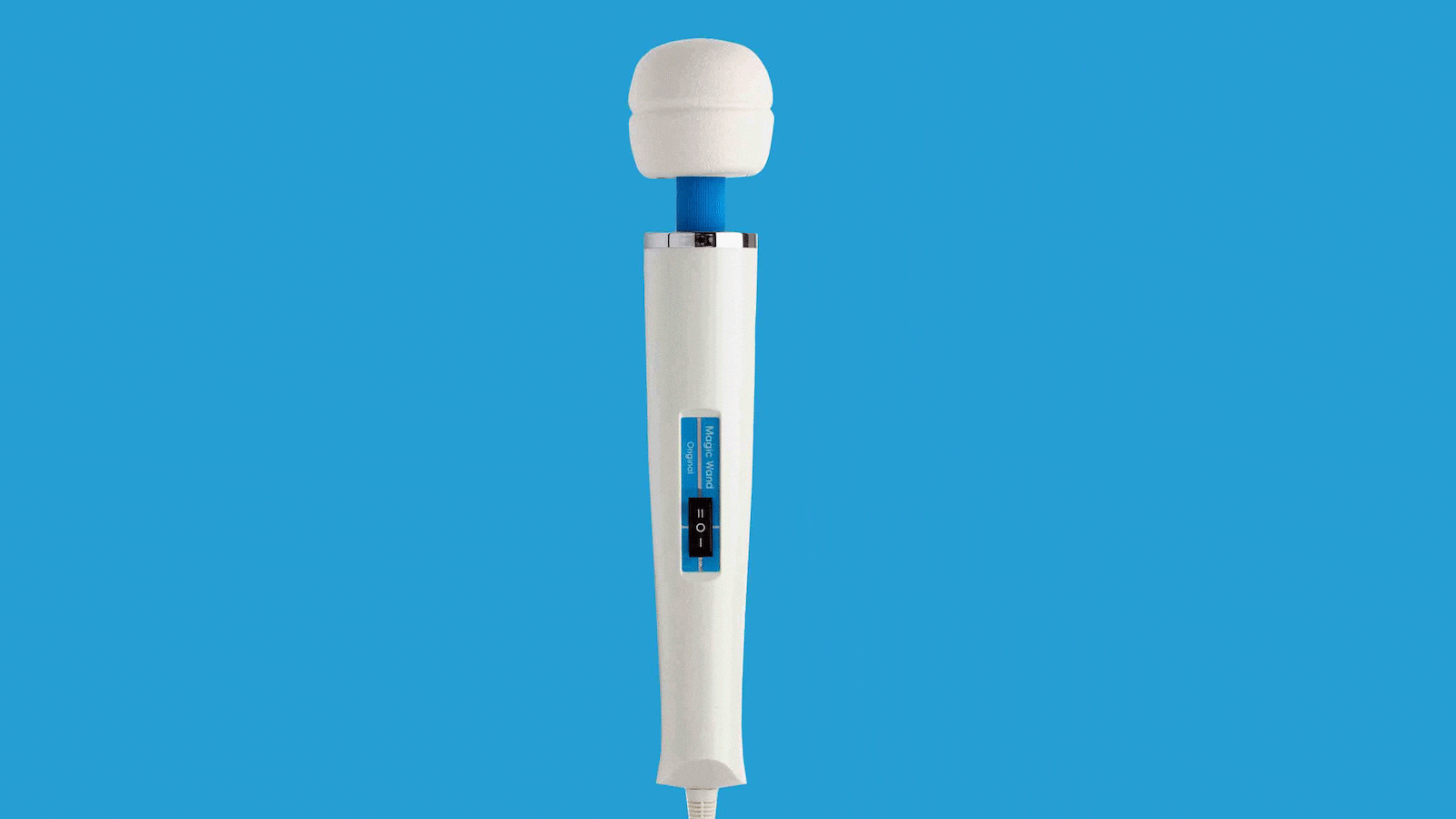Sure, masturbation can be a tool for self-love, a way for a woman to explore her body and relationship to pleasure. But for all the sheet-clutching, toe-curling, Lizzo-song tropes we associate with a female getting herself off, the reality can often be more of an act born out of loneliness or boredom, something to do as a means to distract yourself from laundry day.
That’s partly why some women feel so connected to their vibrators, why people give their Rabbits or Bullets or Eggs names, and why toys are plot points in Sex and the City episodes. It can also help to explain why the Magic Wand has become a muse for popular feminist art, in the same way that graphics of “Nasty Women,” AOC, and cacti are plentiful on Etsy and in independent stores.
Just as being a human in 2020 means that one has access to all kinds of CBD dog treat startups, there is also no lack of sculptural vibrators on the market. Goop sells more than 20, including a necklace hidden beneath 24-karat gold. Lelo’s $219 “Soraya” option appears to be almost comically luxurious, with its “sonographic design” and “ergonomic external stimulator.”
The Magic Wand, meanwhile, looks like what it is: a household appliance from the 1970s. Released by the Japanese conglomerate company Hitachi in 1968 and marketed as a “body massager,” the device was first sold in department stores like Macy’s. According to Engadget, that’s where the sexologist Betty Dodson reportedly bought hers, and over a half-century later, her name has become practically synonymous with the device she encouraged women to use for self-pleasure.
Dodson, now 90, appeared on The Goop Lab, Gwyneth Paltrow’s new Netflix series. She wore a denim jacket covered in patches with affirmations like “Come Together” for the occasion. The episode sought to explore what female pleasure really looks like. It ended with Carlin Ross, the CEO of Dodson’s foundation, masturbating with a Magic Wand in front of a camera crew to dispel porn tropes.
“There are mechanics as to why wand vibrators are good products in the sense that a lot of people prefer a more rumbling vibration, which is based on the motor,” Polly Rodriguez, CEO and founder of sexual wellness company Unbound, told The Daily Beast. “The quality of the rumble correlates to a motor’s size. With a wand vibrator, there is more room for the motor to be large.”
The Magic Wand rotates at two speeds—5,000 rotations per minute and 6,000 rotations per minute. Its strength can be so high that Dodson recommended some women diffuse its buzz by using it through clothes.
Victoria Reuveni, lead educator at the Center for Sexual Positivity in Los Angeles, added that the vibrator “is great for folks who are not comfortable directly touching their bits.”
“It can kind of shock the nervous system in a way, I guess,” Reuveni added. “In the clitoris alone, there are 8,000 nerve endings. That’s a lot, and the power can get too overwhelming, especially if it’s direct.”
For years, the Magic Wand’s use on anything other than relieving back pain was disavowed by Hitachi. In 1999, The Village Voice reported that the company’s head of corporate communications asserted, “Clearly [the Wand] is a straight forward product. There are no implications of anything beyond standard health-care use.”
The next year, Hitachi allowed the California manufacturing company Vibratex to sell the device in the United States. Finally, in 2013, Hitachi officially dropped its name from the Magic Wand, though it is still used by many colloquially. (Both Hitachi and Vibatrex did not respond to The Daily Beast’s request for comment.)
Whatever it is called, the toy still has fans. “The unfortunate reality is, it has stayed around in part not because it’s particularly special from an innovation or quality perspective, but because there’s such a lack of innovation,” Rodriguez said. “It’s iconic, but it’s not revolutionary, it’s just so hard to innovate in the [sex] category. There are barriers like not being able to advertise, which makes it very hard to grow as a company, hard to garner venture capital and financing.”
Laura Szumowski, 36, lives in Chicago and used to work at Early to Bed, a feminist sex shop. “It was always interesting to see the people who would come in for a Hitachi Wand as opposed to a Bullet vibe,” she said. “It has a dedicated following, a sense of nostalgia. I don’t want to say the customers were all older, because they weren’t, but some of them were. A lot of vibrators are so much smaller now, it’s kind of hidden in your hand. The Hitachi is so big that it sticks in your mind.”
Szumowski now works as a head illustrator for The Found, a greeting card and gift company. In 2017, she designed a Magic Wand-shaped pin blazoned with the word, “Self-Love.”
“People just have a visceral response [when they see it],” Szumowski said. “I think it really brings people a lot of joy. It has an association with being liberating and embracing your sexuality, body, and pleasure.”
One artist in Phoenix, Arizona, who asked The Daily Beast use her pseudonym Nadia Vanilla, creates art for those involved the kink community. She sells a $100 watercolor featuring a woman lying in bed, holding a Magic Wand, while a rainbow swirls above her.
“I like to create scenes that are not terribly smutty, but tell a story about what may or may not be happening,” Vanilla, 36, said. “That’s what gets me excited. It’s not so much the wand, because it could be a back massager if you don’t know what you’re looking at. Maybe [she’s] had a really good morning, or maybe she had a really bad day and wants to chill out. I like to let people decide that part.”
Vanilla bought her own Magic Wand online “a few years ago.” At $55, it was one of the first expensive vibrators she purchased. “It came in the mail and my husband made me wait for him to play with it,” she recalled. “It was the most frustrating, slowest afternoon, ever.”
One of Vanilla’s friends has dubbed it “the bulldozer of sex toys,” and she agrees. “I does what it’s supposed to do, which is make people, specifically people with vulvas, feel really fucking good. I can see why people would try to go for something smaller, but I also think that when you know what it’s capable of, it’s suddenly sexy as hell to look at,” Vanilla said.
Emmie Mayne runs the design company Lightning and Lace, and lives in Huntsville, Alabama. She’s never owned a Magic Wand specifically—it’s out of her price range—but has tried similar models. Her $15 ball-post earrings come in the ubiquitous shape, and are a hit at the artist conventions she attends.
“I sometimes get a customer who will playfully ask me, ‘Oh, this is a microphone, isn’t it?’” Mayne said. “To which I say, ‘Of course! And this ‘microphone’ is very travel size. It really is funny how many times people have asked me that. I suppose they’re thinking of what to tell their bosses the earrings are if they wear them to work.”
Mayne thinks the Magic Wand holds a place in the hearts, and top drawers, of many because “it makes people feel bold, saying proudly, ‘I understand what I want [and] need and I’m not afraid to tell you what that is.’” She hopes anyone repping Magic Wand-inspired merch carries that feeling with them into their non-sexual lives, too.
Nour Hantouli, 31, is an artist and tattoo shop apprentice from Memphis, Tennessee. Hantouli, who uses they/them pronouns, runs the Etsy shop Well They Tried. The store sells a stemless wine glass adorned with a Magic Wand, its infamous cord wrapping around text that reads, “I Give Up.” (Hantouli says they are “women-read” by others, meaning “that people like me, who do not identity as women, are still read that way and face the hurdles and the struggles that women face—just because of how people perceive people like me.”)
“The original piece said, ‘Does it spark joy?’” Hantouli explained, referencing the Marie Kondo catchphrase. “[But] that meme was fading, and ‘I Give Up’ is just relatable. Ask anyone who’s ever dated while being perceived as a woman, we’ve all been in that place at least once in our lives.”
“The thing about this vibrator, though, that’s absent from the ‘I Give Up’ image is that the pleasure from the instrument is seen in such a solitary way,” Hantouli added. “I would wager that part of that is the way men feel threatened by the device and its use.”
Hantouli finds “beauty” in the Magic Wand, describing its “simplicity, the subtle curve, and the soothing roundness at the end.” Other sex toys appear as if the designer thought, “‘Let’s take what women need—a dick—and then bedazzle it, because that’s what women like,’” they joked. “[With the Magic Wand], it turns out they actually like treating clitoral pleasure seriously. The form came after the function.”
When Hantouli holds pop-up shops in town, the glasses are “the first thing” people look at. “Women-read people give this knowing look,” they said. “People of all ages [like it], which is surprising, because I think the specific meaning of [the glass] would appeal to millennials and Gen Z. The world’s going to shit, there’s this atmosphere of meaningless, dread, and futility, and at some point it becomes overwhelming. There’s a power that comes with taking a break and caring for yourself.”


